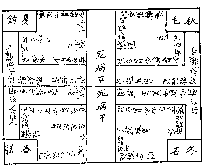|
















| |
 Cupping is a therapy in which a jar is attached to the skin surface to cause local congestion through the negative pressure created by introducing heat in the form of an ignited material. In the ancient times in China, cupping method was called " horn method. "
Cupping is a therapy in which a jar is attached to the skin surface to cause local congestion through the negative pressure created by introducing heat in the form of an ignited material. In the ancient times in China, cupping method was called " horn method. "
The animal horn was used to dispel pus. Along with continual development in clinical practice, the materials for making jars and the methods have been greatly improved. The range of indications has been expanded, since this method is simple and the therapeutic effect is good.
This therapy was attracted with great attention and applied in a large scale by the broad masses, and also used as an auxiliary method of acupuncture and
moxibustion
Types of Jars
There are a great variety of jars, but the commonly used clinically are as follows :
 |
Bamboo jar. Cut down a section of bamboo 3 - 7 cm in diameter and 8 - 10 cm in length, forming a cylinder shaped as a drum. One end is used as the bottom, and the other as the opening. The rim of the jar should be made
smoothly. The bamboo jar is light, economical, easy to make and available in many places. |
 |
Glass cap. Since the glass cup is transparent, the local congestion at the site for moxibustion can be seen so as to control the treatment. |
Indications
The cupping method has the function of warming and promoting the free flow of qi and blood in the meridians, dispelling cold dampness, diminishing swellings and pains. In clinics, the cupping method is mainly used to treat Bi syndrome caused by wind dampness, such as pain of the low back, shoulders, and leg, gastrointestinal disorders such as stomachache, vomiting, and
diarrhea, and the lung disease such as cough and asthma. The cupping method combined with bloodletting is suitable to treat acute sprains accompanied by blood stasis.
Manipulations
 |
Fire throwing method. Throw a piece of ignited paper or an alcohol cotton ball into the cup, then rapidly place the mouth of the cup firmly against the skin on the desired location. This method is applied to the lateral side of the body, otherwise the burning paper or cotton ball may fall and hurt the skin. |
 |
Fire twinkling method. Clamp a cotton ball soaked with 95% alcohol with the forceps or nippers, ignite it and put it into the cup, and immediately take it out and place the cup on the selected position. Generally, the cup is sucked in place for ten minutes. The skin becomes congested with violet
colored blood stasis formation. On withdrawing the cup, hold the cup with the right hand, and press the skin around the rim of the cup with the left hand to let air in. |
In addition, cupping may be combined with the bloodletting technique. First sterilize the area for cupping and prick a small vein with a triangular needle or
intradermal needle, and the cupping follows.
Precautions
 |
The patient should select a comfortable position. Cups in different sizes are used according to the cupping location. Generally, the areas where the muscle is abundant and elastic, free from hairs and bone ridges are selected. |
 |
The burning flame should be stronger enough to create a vacuum. Hold the cup with the rim close to the local area and cup it to the skin rapidly and deftly, otherwise, there will be no therapeutic effects. |
 |
It is not advisable to apply cupping to the patient with skin ulcer, edema, or on an area overlying large blood vessels, to the patient with high fever and convulsion ; or to the abdominal and sacral regions of the pregnant women. |
 |
It is not suitable to apply cupping to the patient susceptible to spontaneous bleeding or endless bleeding after trauma. |
 |
After cupping, there is a blood stasis or bruise at the local area. Generally, it will disappear several days later. Small blisters occurring on the skin will absorb naturally several days later. If the blisters are severe, draw out the liquid by a sterile syringe, apply gentian violet and cover them with
gauze to prevent infection. |
In case cupping is combined with bloodletting, remove the blood from the punctured hole with a dry cotton
ball
The muscle regions and cutaneous regions are the sites where the qi and blood of the meridians nourish the muscles, tendons and skin. Similar to the twelve regular meridians, they are also divided into three hand yin and three hand yang, three foot yin and three foot yang. The muscle regions are deeply distributed under the skin, while the cutaneous regions are located in the superficial layers of the skin.
Disorders of 12 meridians
Zones for cupping
|
